CCRN
Latest uploads at CCRN. Looking for notes at CCRN? We have lots of notes, study guides and study notes available for your school.
-
1400
- 0
-
76
All courses for CCRN
-
CCRN 1394
-
CCRN , 1
-
CCRN 1
-
CCRN! 2
Latest notes & summaries CCRN
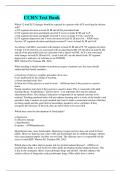
Which 12-lead ECG changes should be expected in a patient with ACS involving the inferior wall? a) ST segment elevation in leads II, III and all the precordial leads b) ST segment elevation and deeply inverted T waves in leads II, III and AvF c) ST segment elevation and deeply inverted T waves in leads V4-V6, I and aVL d) ST segment depression and T wave elevation in leads II, III and AvL - ANSCorrect Answer: ST segment elevation and deeply inverted T waves in leads II, III and AvF An inf...
- Exam (elaborations)
- • 8 pages's •
-
CCRN•CCRN
Preview 2 out of 8 pages
Which 12-lead ECG changes should be expected in a patient with ACS involving the inferior wall? a) ST segment elevation in leads II, III and all the precordial leads b) ST segment elevation and deeply inverted T waves in leads II, III and AvF c) ST segment elevation and deeply inverted T waves in leads V4-V6, I and aVL d) ST segment depression and T wave elevation in leads II, III and AvL - ANSCorrect Answer: ST segment elevation and deeply inverted T waves in leads II, III and AvF An inf...
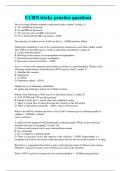
How do young children respond to decreased cardiac output? (cardiac 3) A. SV and HR are increased B. SV and HR are decreased C. SV stays the same and HR is increased D. SV is decreased and HR is increased - ANSC The majority of cardiac arrests in kids are due to - ANSRespiratory failure Adrenergic stimulation is one of the compensatory mechanisms used when cardiac output fails. Which of the following is a result of adrenergic stimulation? (cardiac 6) A. Longer diastolic period B. Blocka...
- Exam (elaborations)
- • 33 pages's •
-
CCRN•CCRN
Preview 4 out of 33 pages
How do young children respond to decreased cardiac output? (cardiac 3) A. SV and HR are increased B. SV and HR are decreased C. SV stays the same and HR is increased D. SV is decreased and HR is increased - ANSC The majority of cardiac arrests in kids are due to - ANSRespiratory failure Adrenergic stimulation is one of the compensatory mechanisms used when cardiac output fails. Which of the following is a result of adrenergic stimulation? (cardiac 6) A. Longer diastolic period B. Blocka...
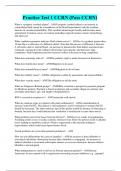
What is vasogenic cerebral edema? - ANSVasogenic cerebral edema is an increase in extracellular fluid caused by a breakdown of the blood-brain barrier with the resultant increase in vascular permeability. This cerebral edema begins locally and becomes more generalized. Common causes are trauma (including surgical trauma), tumors, hemorrhage, and abscesses What ventilator parameter indicates fluid volume excess? - ANSAn A:a gradient greater than 10 mm Hg is a reflection of a diffusion defec...
- Exam (elaborations)
- • 11 pages's •
-
CCRN•CCRN
Preview 2 out of 11 pages
What is vasogenic cerebral edema? - ANSVasogenic cerebral edema is an increase in extracellular fluid caused by a breakdown of the blood-brain barrier with the resultant increase in vascular permeability. This cerebral edema begins locally and becomes more generalized. Common causes are trauma (including surgical trauma), tumors, hemorrhage, and abscesses What ventilator parameter indicates fluid volume excess? - ANSAn A:a gradient greater than 10 mm Hg is a reflection of a diffusion defec...
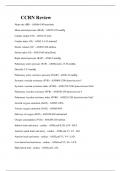
Heart rate (HR) - ANS60-100 beats/min Mean arterial pressure (MAP) - ANS70-105 mmHg Cardiac output (CO) - ANS4-5 L/min Cardiac index (CI) - ANS2.5-4.5 L/min/m2 Stroke volume (SV) - ANS50-100 ml/beat Stroke index (SI) - ANS35-60 ml/m2/beat Right arterial pressure (RAP) - ANS4-8 mmHg Pulmonary artery pressure (PAP) - ANSSystolic 15-30 mmHg Diastolic 5-15 mmHg Pulmonary artery occlusive pressure (PAOP) - ANS8-12 mmHg Systemic vascular resistance (SVR) - ANS800-1200 dynes/sec/cm-5 Systemi...
- Exam (elaborations)
- • 8 pages's •
-
CCRN•CCRN
Preview 2 out of 8 pages
Heart rate (HR) - ANS60-100 beats/min Mean arterial pressure (MAP) - ANS70-105 mmHg Cardiac output (CO) - ANS4-5 L/min Cardiac index (CI) - ANS2.5-4.5 L/min/m2 Stroke volume (SV) - ANS50-100 ml/beat Stroke index (SI) - ANS35-60 ml/m2/beat Right arterial pressure (RAP) - ANS4-8 mmHg Pulmonary artery pressure (PAP) - ANSSystolic 15-30 mmHg Diastolic 5-15 mmHg Pulmonary artery occlusive pressure (PAOP) - ANS8-12 mmHg Systemic vascular resistance (SVR) - ANS800-1200 dynes/sec/cm-5 Systemi...
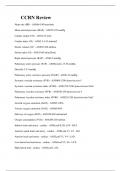
Heart rate (HR) - ANS60-100 beats/min Mean arterial pressure (MAP) - ANS70-105 mmHg Cardiac output (CO) - ANS4-5 L/min Cardiac index (CI) - ANS2.5-4.5 L/min/m2 Stroke volume (SV) - ANS50-100 ml/beat Stroke index (SI) - ANS35-60 ml/m2/beat Right arterial pressure (RAP) - ANS4-8 mmHg Pulmonary artery pressure (PAP) - ANSSystolic 15-30 mmHg Diastolic 5-15 mmHg Pulmonary artery occlusive pressure (PAOP) - ANS8-12 mmHg Systemic vascular resistance (SVR) - ANS800-1200 dynes/sec/cm-5 Systemi...
- Exam (elaborations)
- • 8 pages's •
-
CCRN•CCRN
Preview 2 out of 8 pages
Heart rate (HR) - ANS60-100 beats/min Mean arterial pressure (MAP) - ANS70-105 mmHg Cardiac output (CO) - ANS4-5 L/min Cardiac index (CI) - ANS2.5-4.5 L/min/m2 Stroke volume (SV) - ANS50-100 ml/beat Stroke index (SI) - ANS35-60 ml/m2/beat Right arterial pressure (RAP) - ANS4-8 mmHg Pulmonary artery pressure (PAP) - ANSSystolic 15-30 mmHg Diastolic 5-15 mmHg Pulmonary artery occlusive pressure (PAOP) - ANS8-12 mmHg Systemic vascular resistance (SVR) - ANS800-1200 dynes/sec/cm-5 Systemi...
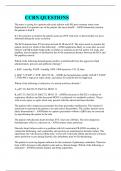
The nurse is caring for a patient with acute inferior wall MI, post-coronary artery stent deployment, For optimal care of the patient, the nurse should: - ANSContinuously monitor the patient in lead II It is best practice to monitor the patient status post PCI with stent, in the lead that was most abnormal during the acute occlusion. The ECG demonstrates ST elevation in leads II, III and aVF. The nurse needs to monitor the patient closely for which of the following? - ANSComplication likel...
- Exam (elaborations)
- • 20 pages's •
-
CCRN•CCRN
Preview 3 out of 20 pages
The nurse is caring for a patient with acute inferior wall MI, post-coronary artery stent deployment, For optimal care of the patient, the nurse should: - ANSContinuously monitor the patient in lead II It is best practice to monitor the patient status post PCI with stent, in the lead that was most abnormal during the acute occlusion. The ECG demonstrates ST elevation in leads II, III and aVF. The nurse needs to monitor the patient closely for which of the following? - ANSComplication likel...
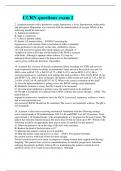
2. A patient presents with a productive cough, hypoxemia, a fever, hypotension, tachycardia, and tachypnea. Hypoxemia was corrected with the administration of oxygen. Which of the following should be done next? A. Administer antibiotics. B. Start a vasopressor. C. Collect a sputum culture. D. Initiate 0.9 normal saline. - ANS(D) Correcting the hypotension (with isotonic fluid resuscitation in order to maintain organ perfusion) is the priority at this time. Antibiotics (choice (A)) will ...
- Exam (elaborations)
- • 15 pages's •
-
CCRN•CCRN
Preview 2 out of 15 pages
2. A patient presents with a productive cough, hypoxemia, a fever, hypotension, tachycardia, and tachypnea. Hypoxemia was corrected with the administration of oxygen. Which of the following should be done next? A. Administer antibiotics. B. Start a vasopressor. C. Collect a sputum culture. D. Initiate 0.9 normal saline. - ANS(D) Correcting the hypotension (with isotonic fluid resuscitation in order to maintain organ perfusion) is the priority at this time. Antibiotics (choice (A)) will ...
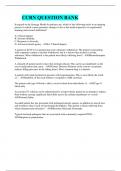
In regards to the Synergy Model for patient care, which of the following refers to an ongoing process in which a nurse generates changes to his or her medical practice via experiential learning and research utilization? A. Clinical inquiry B. Systems thinking C. Response to diversity D. Advocacy/moral agency - ANSA. Clinical Inquiry A patient in the ICU is experiencing acute substance withdrawal. The patient is presenting with symptoms similar to alcohol withdrawal, but it is known that ...
- Exam (elaborations)
- • 1 pages's •
-
CCRN•CCRN
Preview 1 out of 1 pages
In regards to the Synergy Model for patient care, which of the following refers to an ongoing process in which a nurse generates changes to his or her medical practice via experiential learning and research utilization? A. Clinical inquiry B. Systems thinking C. Response to diversity D. Advocacy/moral agency - ANSA. Clinical Inquiry A patient in the ICU is experiencing acute substance withdrawal. The patient is presenting with symptoms similar to alcohol withdrawal, but it is known that ...

You are monitoring a patient with a pulmonary artery catheter. You are unable to measure the patient's pulmonary artery wedge pressure. To obtain a value that corresponds to the pulmonary artery wedge pressure, you check the: A. Right ventricular pressure B. Pulmonary artery diastolic pressure C. Pulmonary artery mean pressure D. Right atrial pressure - ANSB. Pulmonary artery diastolic pressure When you cannot obtain a pulmonary artery wedge pressure, use the pulmonary artery diastolic ...
- Exam (elaborations)
- • 4 pages's •
-
CCRN•CCRN
Preview 1 out of 4 pages
You are monitoring a patient with a pulmonary artery catheter. You are unable to measure the patient's pulmonary artery wedge pressure. To obtain a value that corresponds to the pulmonary artery wedge pressure, you check the: A. Right ventricular pressure B. Pulmonary artery diastolic pressure C. Pulmonary artery mean pressure D. Right atrial pressure - ANSB. Pulmonary artery diastolic pressure When you cannot obtain a pulmonary artery wedge pressure, use the pulmonary artery diastolic ...
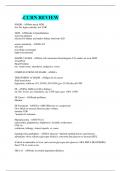
SIADH - ANStoo much ADH low Na, hypo-osmolar, low UOP ADH - ANSmade in hypothalamus stored in pituitary released to kidney and makes kidney hold onto h20 serum osmolarity - ANSNa X2 275-295 low=fluid overloaded high=concentrated SIADH CAUSES - ANSoat cell carcinoma (bronchogenic CA)-makes its own ADH Viral PNA Head Problem inc. serum osmo, anesthesia, analgesics, stress COMPLICATIONS OF SIADH - ANSSz's TREATMENT of SIADH - ANSget rid of causes fluid restrictions hypertonic solut...
- Exam (elaborations)
- • 16 pages's •
-
CCRN•CCRN
Preview 3 out of 16 pages
SIADH - ANStoo much ADH low Na, hypo-osmolar, low UOP ADH - ANSmade in hypothalamus stored in pituitary released to kidney and makes kidney hold onto h20 serum osmolarity - ANSNa X2 275-295 low=fluid overloaded high=concentrated SIADH CAUSES - ANSoat cell carcinoma (bronchogenic CA)-makes its own ADH Viral PNA Head Problem inc. serum osmo, anesthesia, analgesics, stress COMPLICATIONS OF SIADH - ANSSz's TREATMENT of SIADH - ANSget rid of causes fluid restrictions hypertonic solut...
